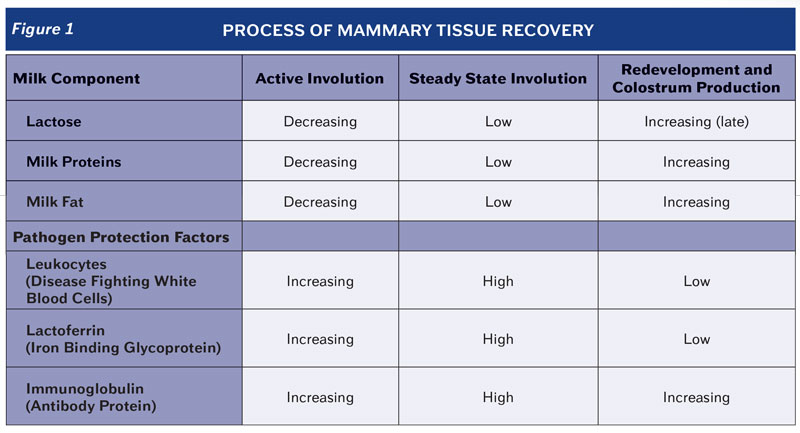The Recovery Period: Tips For A Successful Dry Off
Click here to view as a pdf: The Recovery Period: Tips For A Successful Dry Off
The dry cow period is arguably the most important time in the cow’s lactation cycle as it is the time in which the cow rests her body and prepares for the next lactation. The timing and way in which a cow is dried off can greatly impact how well she will transition into the dry period and how well she will come into her next lactation. A properly managed dry off protocol should minimize the risk of mastitis, maximize cow comfort and allow for mammary tissue rest and recovery in preparation for the next lactation.
There are many questions surrounding the topic of dry off including:
1) How important is the dry period?
2) What is the optimal length of time for a dry period?
3) What steps should be taken when drying cows off?
Importance Of The Dry Period
The dry cow period should not be thought of as the end of one lactation, but actually as the set up for the upcoming lactation. More than just the mammary tissue is rejuvenated during this time. With the stress of lactation removed, rumen health, hoof health and immunity can be strengthened.
Lactating rations have higher energy and starch levels, with lower fiber levels, than dry cow rations. While being fed a lactating diet, cows may develop sub-acute rumen acidosis at some point during their lactation. This acidotic state damages the rumen’s lining, causing damage that has negative effects on the absorption of nutrients, which in turn affects overall animal health. A high fiber, low starch dry cow ration allows for the recovery of the ruminal wall, setting the cow up for maximum nutrient absorption and fiber digestion in the upcoming lactation.
Hoof health can suffer under the stress of lactation, leading to lameness and ultimately, decreased production. Many producers find that dry off is a great time to trim hooves. Trimming can remove areas of damage and fix the hoof to set it up for proper re-growth. The hoof face grows at a rate of 0.16 to 0.20 inches per month1. The total sole surface is anywhere from 0.28 – 0.47 inches, meaning that after a 2 month (60 day) dry period, the entire sole is re-grown, recovered and ready for lactation1. This re-growth and rebuilding strengthens the hoof, making the cow more mobile and more comfortable lying down and getting up, which in turn will increase feed intake, reduce risk of metabolic problems at freshening and increase profitability in the upcoming lactation.
A strong, healthy immune system starts with high quality nutrition. A well-balanced dry cow ration and a highly bioavailable mineral source are needed to maximize immune function and ensure optimum recovery in the dry period. Crystal Creek® Dry Cow Mineral is formulated with polysaccharide chelated trace minerals, 100% selenium yeast and strong vitamin fortification to support immune function and tissue recovery. These factors are crucial to not only decreasing the risk of infection, but also prepping the cow to be more profitable in her next lactation.
Crystal Pellets™ and Crystal Creek® Whole Leaf Aloe Vera Juice are two nutritional supplement products that contain aloe vera for a flavoring agent. The natural ingredients in these products have been scientifically proven to decrease inflammation, stimulate the immune system along the gastrointestinal tract, promote nutrient absorption in the lower gastrointestinal tract and promote antioxidant regeneration. Crystal Pellets™ are a very powerful tool in assisting the immune system to prevent infections at the beginning of the dry period and can also be fed the last two to three weeks of the dry period to boost immune function at the time of calving.
Vaccines can be used during the dry cow period to help prevent disease and enhance immune related responses. Many vaccines used in dry cows have double benefits. Using a vaccine not only improves the cow’s immune system, but can increase the levels of antibodies in the colostrum to be passed on to the cow’s newborn calf. Producers are encouraged to work with their herd veterinarian to determine which dry cow vaccines are needed in their operation and when those vaccines should be given.
The rejuvenation of mammary tissue can be broken down into three distinct phases (Figure 1). Active involution, steady state, and redevelopment/generation of colostrum1. In the active involution stage, the udder is shutting down milk production and ramping up pathogen protection. The steady stage keeps things consistent, continues to protect the mammary tissue from infection and prepares for the transition into lactation. The third and final stage of the dry period is when the cow begins to work towards producing milk again. Energy is diverted to focus on fat, protein, and fluid volume while pathogen protection will begin to weaken.
Length Of Dry Period
While there is some debate on what the ideal length is for the dry period, it is agreed that a minimum of 45 days should be required2. Dry cow periods that are less than 40 days, or greater than 80 days, have been shown to decrease milk production in subsequent lactations2. Crystal Creek® recommends a 60-day dry cow period. A 60-day dry cow period is long enough to provide the time needed for recovery, but returns cows to the milking herd, in a timely manner, where they are generating revenue again. Studies show that cows given at least 60 days for a dry period, produce on average, 249 pounds more milk in the next lactation2.
Steps For A Successful Dry Off
Cows that are still producing large volumes of milk at dry off are at an increased risk of developing mastitis in the dry period. These cows will use their white blood cells to absorb and get rid of milk fat cells rather than using them to defend against bacterial infections1. They also do not produce a protective keratin plug in the teat canal. Keratin, which is a fibrous protein, forms a barrier in the teat canal that impedes bacteria from entering1. If large volumes of milk are being produced and leaking out of the udder, this keratin barrier is never formed. This, coupled with the lack of active white blood cells, greatly increases the risk of an infection developing.
The best way to decrease milk yield is to limit the intake of high quality, high energy feeds in the lactating diet. Typically, all grain is removed from the diet one to two weeks prior to the start of the dry cow period. The introduction of lower quality, fibrous, grassy hay can also help lower energy concentrations. Limiting water intake is highly effective in decreasing milk production in the last few days before the planned dry off date. While there is some debate about decreasing the frequency of milking, most sources agree, using an abrupt dry off is best to cease milk production while preventing infections. Any stimulus that would encourage milk production during dry off should be avoided.
The way in which cows are dried off, the length of the dry cow period, and how cows are fed and handled while they are dry, all have a significant impact on cow health and productivity. Cows that are allowed adequate time to rest and rebuild will be more productive animals. Cows that are transitioned into the dry period in a manner that limits exposure to pathogens will freshen in as more profitable cows for the farm. To learn more about dry off strategies, call 1-888-376-6777 to talk with one of our knowledgeable staff.
SOURCES:
-
Swinkels, Jantijn and Boersma, Rinse Jan, The Dairy Site, (September 2010), “The Dry Cow Period Step-By-Step”, Retrieved from http://www.thedairysite.com/articles/2464/the-dry-cow-period-stepbystep/
-
University of Illinois Extension, (August, 2004) “New Ideas in Dry Cow and Transition Management” Retrieved from http://livestocktrail.illinois.edu/dairynet/paperDisplay.cfm?ContentID=6758



